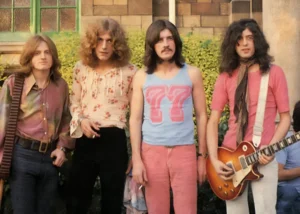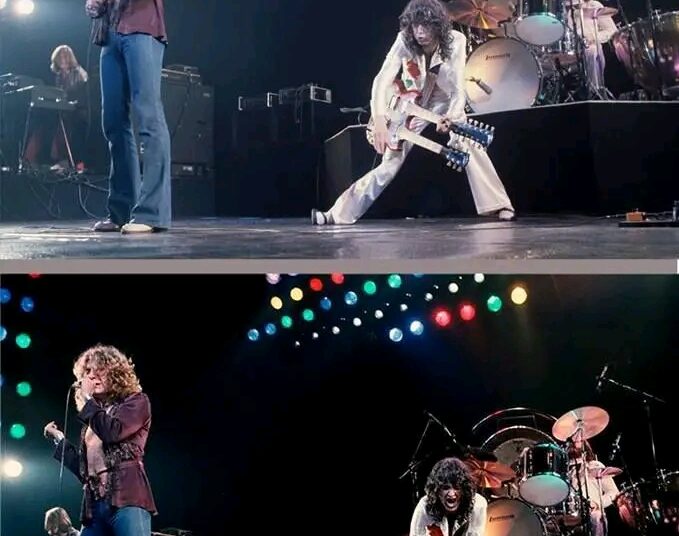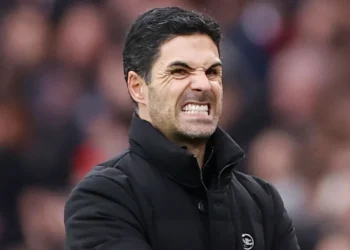Led Zeppelin’s First Concert: September 7, 1968, Gladsaxe, Denmark
On September 7, 1968, in the unassuming setting of the Gladsaxe Teen Club in Denmark, rock history quietly began to unfold. On that evening, a band billed as “The New Yardbirds” took to a makeshift stage in a converted gymnasium. Little did the 1,200 fans in attendance realize they were witnessing the birth of one of the greatest rock bands of all time—Led Zeppelin.
The story of this first concert is rooted in transition. Earlier that year, The Yardbirds, a pioneering British rock group known for their blues-infused sound, had disbanded. Guitarist Jimmy Page, however, was determined to honor the band’s remaining tour commitments. To do so, he assembled a new lineup. Page recruited Robert Plant, a powerful and expressive singer from West Bromwich, John Paul Jones, an accomplished session musician and bassist, and John Bonham, a thunderous and dynamic drummer. Although they were still known as “The New Yardbirds” due to contractual obligations, the chemistry among the four musicians quickly suggested that they were destined for something far greater.
The venue for their first performance, the Gladsaxe Teen Club, was modest by any standard. Situated in a suburb of Copenhagen, it was essentially a gymnasium that had been converted for youth gatherings and concerts. It was not the kind of place one would associate with the beginning of a musical revolution. Yet, for this debut performance, the energy in the room was electric. There was an undeniable sense of excitement, though few could have predicted the monumental legacy that would sprout from this modest start.

The setlist for the night featured a blend of blues covers and Yardbirds material, along with early versions of songs that would later become staples of Led Zeppelin’s repertoire. Songs like “Dazed and Confused,” which had previously been a Yardbirds live favorite, found new life and expanded dimension through the extraordinary interplay between Page’s guitar, Plant’s vocals, Jones’s bass, and Bonham’s drums. Early performances also included covers like “Train Kept A-Rollin’,” “I Can’t Quit You Baby,” and “You Shook Me,” all of which showcased the band’s deep roots in American blues, filtered through their uniquely intense and aggressive style.
The reception from the Gladsaxe crowd was overwhelmingly positive. Reports from the event describe the audience as being completely captivated by the raw energy and sheer musical prowess of the group. Even in this embryonic stage, it was clear that there was something special happening. In fact, the local Danish newspaper Politiken would later publish a review declaring that “The New Yardbirds” were something very much out of the ordinary—a prophecy that would be confirmed many times over in the years to come.
This concert also marked the first time the band’s legendary on-stage dynamic was put on full display. Jimmy Page’s guitar wizardry, employing a violin bow on his instrument to create otherworldly sounds; Robert Plant’s soaring, almost primal vocals; John Paul Jones’s steady, inventive basslines and versatile keyboard work; and John Bonham’s explosive drumming formed a powerful, cohesive unit that pushed beyond the conventions of rock at the time. They weren’t just playing songs; they were creating a soundscape that was physical, emotional, and wholly immersive.

Following their debut in Gladsaxe, the band continued to tour Denmark and Sweden, fulfilling the remaining Yardbirds dates. Each performance strengthened their bond, honed their sound, and built momentum. By the time they returned to England, they had already begun to shed the “New Yardbirds” moniker. Not long after, they officially adopted the name Led Zeppelin—a name reportedly suggested by The Who’s Keith Moon, who joked that the band would go down “like a lead balloon.”
What happened at the Gladsaxe Teen Club that night was a rare moment where fate, talent, and timing all aligned. In many ways, it encapsulated the spirit of Led Zeppelin’s entire career: a band that was constantly pushing forward, always defying expectations, and creating art that resonated on a deep, almost primal level.
The legacy of that night lives on not just in bootlegs or newspaper clippings but in the DNA of rock music itself. Every time a band steps onto a stage and turns up the volume, every time a guitarist bends a note into a shriek of emotion, every time a drummer rattles the walls with primal intensity, the echoes of that first Led Zeppelin performance can be heard.
In retrospect, it seems almost poetic that their journey began not in a massive arena or on a grand televised broadcast but in a humble gymnasium in Denmark, playing to a crowd that was simply there for a good time. Greatness often begins in the most unassuming of places, and for Led Zeppelin, it all started on September 7, 1968, at the Gladsaxe













